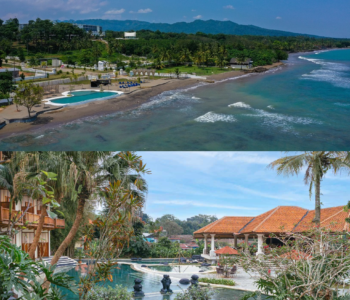When Ice Tede Dara first arrived at the Indonesian Heritage Society for her presentation with Genevieve Duggan, she was, she says, “nervous.” “I don’t speak English very well,” she apologized.

Never could she have imagined that this place, where she brought to light her story, so far from where she grew up in Savu, would be her stage. We meet a few days later at Nusa Gastronomy to chat with her. She is there at the 13th Annual Meet the Maker’s Exhibition, with over 15 other artisans sharing their journeys of “craft as art”. Ice settles into her backstrap loom and begins to weave a few picks of the selendang currently warped. “My grandma didn’t let me weave until I was six years old. I saw other children my age weaving but I wasn’t allowed.” She’d been raised to think of new motifs—and synthetic dyes—as untraditional.
Ice, now 30, and a mother of 2 boys, grew up in a secluded, rural hamlet in Pedero Savu, NTT. (Savu is a small island with an isolated location between Sumba and Timor.) As the eldest of four, the women in her family have straddled the increasing presence and influence of the outside world for over three generations. Ice belongs to the Lesser Blossom clan and was raised by her maternal grandmother, Ina Ga, to revere and adhere to the process of weaving traditional Savunese motifs and to respect the meaning and power of natural dyes. She describes proudly the first time she ikatted a men’s hipcloth or selimut at the age of 15. She didn’t live with her mother, who had moved away from the village, until she was 17 and attending high school. During this time, she continued to ikat in order to help her mother pay for the school fees. It was at this time that she came to be pictured in the tourism journal Wisata in 2006. A private sponsorship in 2007 gave her the opportunity to study economics and finance at the University of Nusa Cendana in Kupang, Timor, but again she still found herself ikatting and weaving in her free time both as an income generator as well as allowing her to hone her skills.
Ice spoke about her evolution in a beautiful and compelling presentation, Three Generations of Weavers: Heritage Weavings, Tense Present and Uncertain Future at the Indonesian Heritage Society. Despite the ominous title, Ice’s voice remains hopeful. Yes, there are hardships, the depictions of which are comparable to the struggles faced by other indigenous weavers in Indonesia. But her experience is also a remarkable story of a young girl finding her own path by leaving her village to study in Timor all the while still maintaining her ancestor’s tradition of weaving (thread of kinship). This would be impressive enough for any indigenous weaver from a small island, but the fact that she commands an audience in English renders Ice’s achievement extraordinary. And despite the singularity of her childhood and the experiences of both her grandmother and mother, the questions her experience poses are universal: How do we honour and pay tribute to our traditions without losing ourselves? How do you balance cultural identity and maintain authentic meaning against the desires of commodification? How do you continue to look forward without losing sight of the past?

Small, shy, and poised in a Savunese sarong and selendang draped over her shoulders, Ice looks, talks and lives the ancestral traditions of her hamlet. But in a small purse, a vibrating cell phone tells the story of a modern woman keeping in contact with her family and friends. “To be a woman in Savu, is to be a weaver,” Ice clarifies. It’s through weaving that you fulfil your family’s needs.” Ice’s grandmother, Ina Ga, was born in 1943 and had no formal education. Growing up, she learned all the aspects of weaving from cleaning and fluffing cotton buds to spinning—ultimately finishing her first ikatted piece at the age of 17. “This moment was significant for a woman in our clan as it symbolized that my grandmother was ready to be married,” Ice emphasizes. On Savu, weaving represents an alternative source of income for most families and serves to maintain each family’s heritage and identity through an intricate array of motifs and banding. “After her marriage and the birth of her first child, [Ice’s mother] Ina Ga was permitted to handle indigo dye.” Due to the power of the indigo dye, only married women are considered mature enough to undertake the process. Although Ice’s grandmother is no longer weaving today, “she still performs the indigo dye processes and the ceremonies linked to dye and weaving processes,” Ice beams.
In fact, for years, Ina Ga refused to teach her firstborn, Ice’s mother, the indigo dye process. Ice describes her own mother, Obo, as retracting from her traditional roots. Despite watching and learning from other weavers as a child, she yearned for more than a quiet hamlet life. With no more than a primary school education, Obo left Savu to work as a household help in Kupang, Timor. For ten years, she “worked abroad”—converting to Christianity in the process. Later, Obo resettled in Savu and resumed weaving. Only until a Thread’s of Life seminar on natural dyes, did Obo give up weaving with synthetic dyes and ask Ina Ga for permission to learn traditional indigo dye techniques. With her blessing, Obo successfully mastered the indigo dye process and now leads a local weaving cooperative.
As the third generation, Ice’s journey bears similarities to both her grandmother and mothers’. Unlike with her mother, Obo, Ina Ga was reluctant to teach Ice to weave. “[At the time] my grandmother thought I would break things,” Ice explains. This is to be expected as she was only five years old. But what child has ever listened to what their elders say? “When she left the house I would collect scraps of thread I found and try to weave,” Ice confesses with a smile. “Upon my grandmother’s return she would discover the broken threads or a distorted weaving.” “She was so mad,” Ice laughs.
Ice’s life is quite different to her grandmother’s life but the tradition of weaving and the motifs unique to her family lives on. As a Christian, Ice’s mother is not held by the same belief system so she’s free to weave whatever motifs she likes; whereas, Ice’s grandmother is trying to keep the motifs woven as traditional as possible.
Ice currently works as a junior school (SMP) teacher in her village. She is a leader in the community-weaving group, Tewuni Rai. Tewuni Rai was founded in 2006 with the aim of passing on the unique cultural techniques and knowledge by the master weavers of the region, while also adapting the techniques to produce fashion items for sale. Ice continues to actively promote the weavers of Savu at events like Meet the Makers while continuing her studies and being a mom to two growing boys. She has also presented her research, alongside Genevieve Duggan, in January 2016 at the ASEAN textile conference in Chiang Mai—an impressive list of achievements!
We ask her if she has any hopes for the future of her sons and their village. “I hope that they remain good kids,” she says. “For my village, I hope the government invests in community projects such as a communal house.”
Text by Kelly Kluvers and Debra Cleveland. This article is originally from paper. Read NOW!Jakarta Magazine May 2019 issue “Can Jakarta Really Change?”. Available at selected bookstore or SUBSCRIBE here.







